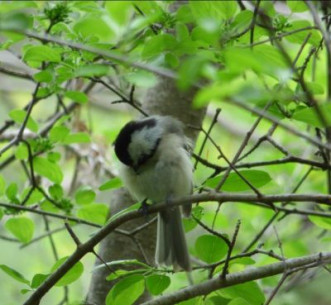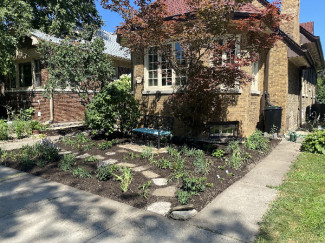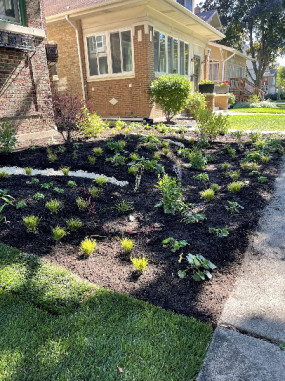Let's Continue to Root for Natives!
It's January and although the weather is cool, this is a great time to re-imagine your garden space and prepare for spring.
As you dream of providing an oasis for birds, bees and butterflies, you can begin by shrinking your lawn space.
Doug Tallamy, the author of Nature's Best Hope, suggests reducing your lawn by at least half, confining it to paths and garden borders as "cues" that you have a garden and not an unruly mess. Lawns provide hardly any ecological benefits and, after saturation from a good rain, actually lose the ability to absorb water, effectively becoming as impervious as concrete!
Research shows that a Chickadee in your garden needs between 6000 and 9000 caterpillars to provide their babies enough nutrition to leave the nest. Planting certain keystone native species is essential for supporting the food web that exists in our garden spaces.
Keystone plants provide food and shelter for the development of these valuable caterpillars. Several shrubs and trees are especially useful to greater numbers and insects, birds and animals. But there are valuable perennial plants as well which are vital to supporting these creatures.
What is unique about our region is that it includes a natural ecosystem type known as a Savanna. In May of 2022, Julia, who founded the Spirited Gardener, actually gave a presentation on how gardens in many cities and towns of the Chicago area have ratios of trees on properties that easily fit into this ecological niche. Click here if you want to view the YouTube recording of the Zoom presentation to learn more.
Savanna plants are literally a merger between the two larger systems that border our region and which contain Keystone plants of both systems that we can use in our yards! To see a list of these plants check below.
A great resource for a list of Keystone plants can be found on the Homegrown National Park website. They even have a recent article on how to grow these essential plants in large containers. There are two lists relevant to this region. The list of plants we include here are based on the Eastern Temperate Forest ecosystem, but note that we also have the option in our region to choose plants from the Great Plains list. Some of our favorites include the Orange Coneflower (Rudbeckia fulgida), Common Evening Primrose (Oenothera biennis), Blanketflower or Firewheel (Gaillardia pulchella), Wreath Goldenrod (Solidago caesia), Blue Wood Aster (Symphyotrichum cordifolium), Smooth Aster (Symphyotrichum laeve), Woodland Sunflower (Helianthus divaricatus), Lanceleaf Coreopsis (Coreopsis lanceolata) and, last but not least, Black-Eyed Susan (Rudbeckia hirta).
You can also add your native garden to the interactive Home Grown National Park's Map. Help contribute to our national goal of "converting ½ of the 40 million U.S. acres now in lawns into 20 million acres of thriving landscapes built from native plants."
If you'd like help increasing the number of native plants in your garden to at least 75% (or more,) contact us.
 This makes homes for all those delightful insects that need to overwinter here and emerge next spring! Here's information shared by the highly regarded Xercis Society's Bumble Bee watch.
This makes homes for all those delightful insects that need to overwinter here and emerge next spring! Here's information shared by the highly regarded Xercis Society's Bumble Bee watch.
We've had a busy season installing fun projects of all shapes and sizes. Unique problems have inspired creative solutions. The Savanna-like conditions of two of these properties help evoke a beautiful sense of place, while the Prairie sensibility dominates the Evanston home.
 OAK PARK, IL
OAK PARK, IL
.

After: We removed the Lily of the Valley, replanted the Hydrangeas, and provided a space where the home owners can sit and enjoy their native garden and interact with neighbors (hopefully to convince them to plant more natives too!).


 Scott recently passed his exam to become certified with the National Green Infrastructure Certificate Program through the Ecological Landscaping Association. The NGICP adds to the skill set needed for our team to properly construct, inspect and maintain green stormwater infrastructure such as rain gardens, vegetated swales and green roofs.
Scott recently passed his exam to become certified with the National Green Infrastructure Certificate Program through the Ecological Landscaping Association. The NGICP adds to the skill set needed for our team to properly construct, inspect and maintain green stormwater infrastructure such as rain gardens, vegetated swales and green roofs.
Implementing these strategies on your property can reduce the amount of dark surface available to collect and hold solar heat as well as provide new opportunities for trees and bushes to create shade. These measures reduce the “heat island effect” in cities and heavily developed areas.

We are always looking for seasonal workers who want to learn more about Native plant Landscaping & Eco-functional Rain Gardens, and who enjoy outdoor, physical work. Help us plant gardens and provide ongoing stewardship during the season. There will be lots of learning opportunities. We offer a positive work environment & good hourly wages. For more information please contact Julia at Spirited Gardener's email address: spiritedinfo1@gmail.com. There is opportunity for the right person to grow with our company.
As you dream of providing an oasis for birds, bees and butterflies, you can begin by shrinking your lawn space.
Doug Tallamy, the author of Nature's Best Hope, suggests reducing your lawn by at least half, confining it to paths and garden borders as "cues" that you have a garden and not an unruly mess. Lawns provide hardly any ecological benefits and, after saturation from a good rain, actually lose the ability to absorb water, effectively becoming as impervious as concrete!
Research shows that a Chickadee in your garden needs between 6000 and 9000 caterpillars to provide their babies enough nutrition to leave the nest. Planting certain keystone native species is essential for supporting the food web that exists in our garden spaces.
Keystone plants provide food and shelter for the development of these valuable caterpillars. Several shrubs and trees are especially useful to greater numbers and insects, birds and animals. But there are valuable perennial plants as well which are vital to supporting these creatures.

A Chickadee preening on an invasive Buckthorn at Harbert Payne Park in Evanston
Keystone Plants to Support Nature
What is unique about our region is that it includes a natural ecosystem type known as a Savanna. In May of 2022, Julia, who founded the Spirited Gardener, actually gave a presentation on how gardens in many cities and towns of the Chicago area have ratios of trees on properties that easily fit into this ecological niche. Click here if you want to view the YouTube recording of the Zoom presentation to learn more.
Savanna plants are literally a merger between the two larger systems that border our region and which contain Keystone plants of both systems that we can use in our yards! To see a list of these plants check below.
You can also add your native garden to the interactive Home Grown National Park's Map. Help contribute to our national goal of "converting ½ of the 40 million U.S. acres now in lawns into 20 million acres of thriving landscapes built from native plants."
If you'd like help increasing the number of native plants in your garden to at least 75% (or more,) contact us.
Remember: Leave the leaves (without mowing them)!
 This makes homes for all those delightful insects that need to overwinter here and emerge next spring! Here's information shared by the highly regarded Xercis Society's Bumble Bee watch.
This makes homes for all those delightful insects that need to overwinter here and emerge next spring! Here's information shared by the highly regarded Xercis Society's Bumble Bee watch.3 Ways to Support Bumble Bees Right Now
(Information published here comes directly from their 10/19/22 e-newsletter )
- Habitat
- Whatever size land you steward, think about big picture when it comes to habitat.
Most of us go to planting flowers first, with hopes of offering bees a nutritious meal.
But what about a area to nest and raise young? Or a place to safely overwinter?
- Whatever size land you steward, think about big picture when it comes to habitat.
- Leave The Leaves
- Leaves and other ground "litter" are essential for overwintering queens.
Find ways to incorporate nature's "mess" like branches and brush into your aesthetic.
This habitat will provide safety for numerous species of bees, butterflies, moths, and more!
- Leaves and other ground "litter" are essential for overwintering queens.
- 2023 Garden
- Fall and winter are great times to start on planning next year's garden.
Consult with local nurseries to find native plants that are free of pesticides.
Aim to have flowers in bloom from the early spring through late summer to support the entire bumble bee life cycle.
- Fall and winter are great times to start on planning next year's garden.
Highlights from Our Season
We've had a busy season installing fun projects of all shapes and sizes. Unique problems have inspired creative solutions. The Savanna-like conditions of two of these properties help evoke a beautiful sense of place, while the Prairie sensibility dominates the Evanston home.
 OAK PARK, IL
OAK PARK, ILBefore: A typically neat, but not especially
eco-functional, garden space in Oak Park.
After: Yew hedge and lawn removed, we artfully prepared the earth to create a ponding area. We encouraged the client to direct all their downspouts there and populated it with plants adapted to periodic flooding. These plants are native to the Chicago region and have therefore co-evolved with our native pollinators, which depend on them for sustenance.




.
WEST ROGERS PARK (CHICAGO), IL
Before: This client wanted to have a front garden space that provided a habitat where humans and wildlife can interact

After: We removed the Lily of the Valley, replanted the Hydrangeas, and provided a space where the home owners can sit and enjoy their native garden and interact with neighbors (hopefully to convince them to plant more natives too!).

EVANSTON, IL
We expanded one of our favorite projects by creating a garden design for this parkway space. Caging was necessary to deter rabbits from some of the young plantings. Note: Permits were necessary, so consider speaking to your local city department about how you can create extra space for plants and wildlife.
Always Learning and Growing
 Scott recently passed his exam to become certified with the National Green Infrastructure Certificate Program through the Ecological Landscaping Association. The NGICP adds to the skill set needed for our team to properly construct, inspect and maintain green stormwater infrastructure such as rain gardens, vegetated swales and green roofs.
Scott recently passed his exam to become certified with the National Green Infrastructure Certificate Program through the Ecological Landscaping Association. The NGICP adds to the skill set needed for our team to properly construct, inspect and maintain green stormwater infrastructure such as rain gardens, vegetated swales and green roofs.Implementing these strategies on your property can reduce the amount of dark surface available to collect and hold solar heat as well as provide new opportunities for trees and bushes to create shade. These measures reduce the “heat island effect” in cities and heavily developed areas.

Scott working on redirecting a downspout from the alley to the garden.
Know Anyone who wants to Learn more about Working with Nature to Create these Places?
We are always looking for seasonal workers who want to learn more about Native plant Landscaping & Eco-functional Rain Gardens, and who enjoy outdoor, physical work. Help us plant gardens and provide ongoing stewardship during the season. There will be lots of learning opportunities. We offer a positive work environment & good hourly wages. For more information please contact Julia at Spirited Gardener's email address: spiritedinfo1@gmail.com. There is opportunity for the right person to grow with our company.




